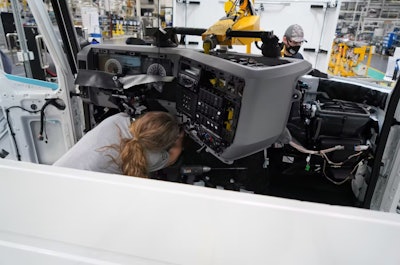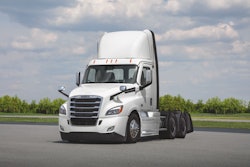
With no long-term relief in sight from a component shortage that's hindered truck build rates for a year, Class 8 net orders in December hit 22,800, according to preliminary released by ACT Research.
Production backlogs already stretch through this year and ACT President and Senior Analyst Kenny Vieth said last month's order totals "reflect OEMs taking a more cautious approach to effectively manage the cycle of customer expectations."
"After hitting a [Class 8] cancellation speed-bump in November, orders rebounded to a level just above the second half of 2021 production trend in December. However, while improved, December’s orders were the second weakest of the year, reflecting ongoing supply-side shortages that continue to constrain production," Vieth said. "Importantly, we reiterate, with critical economic and industry demand drivers at, or near, record levels, industry strength is exhibited in long backlog lead-times, rather than in seasonally weak orders.”
The December total orders were back in the same range as September and October, following the previous trend of orders being slightly above expected production levels, FTR noted, adding Class 8 orders totaled 365,000 units for 2021.
"The current order volume still understates the tremendous demand for new trucks. The OEMs have a large number of fleet commitments for 2022. They are delaying entering these orders until they know how many they will be able to build each month," said Don Ake, vice president of commercial vehicles for FTR. "Fleets need a considerable number of new trucks right now. Industry capacity is extremely tight, resulting in elevated freight rates. The carriers have freight to haul and funds available for new trucks, but OEMs can’t build enough. Also, the large fleets have had to run vehicles beyond their trade-in cycles and need replacement trucks.”
Pandemic's lingering effects
Despite mostly widespread vaccination, the U.S. currently stands on the doorstep of year-two of the coronavirus pandemic and the third variant of the virus. With little improvement in global COVID cases, Vieth said not to expect much improvement in production rates.
"Minimally, the world should be planning for a January of meaningful labor disruption, and by extension, increased manufacturing challenges, locally and globally," he said, noting that low-cost manufacturing countries with low vaccination rates have had trouble in previous COVID waves. "The Delta variant knocked Indian steel production off-line and disrupted automotive sub-assemblers in Southeast Asia. To combat omicron, the Chinese government has instigated shelter-in-place quarantines, continuing their strict lockdown policy. As China remains the world’s workshop, Chinese parts suppliers and ports going off-line is a real short-term risk.”
Medium duty orders closed 2021 strong, mostly because large pickup-based OEMs were able to move chips from smaller to larger GVW vehicles, Vieth said.
"With fewer components requiring semiconductors, trailer production also showed some modest traction into year-end, suggesting some easing in commodities capacity," he added. "It appears that the industry will begin 2022 with still unfinished 2021 units. At the levels we suspect, this is an unprecedented situation. If your company has parts on all those ‘built, but not built’ units, some adjustment will be required to align your 2021-2022 output with reported and forecast data.”









